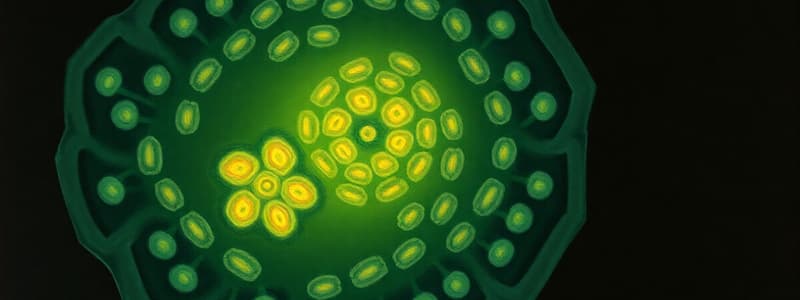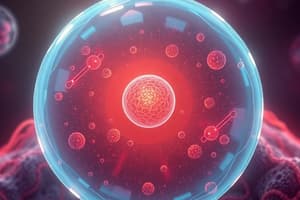Podcast
Questions and Answers
Which cellular component is ubiquitous across both prokaryotic and eukaryotic cells, underscoring its fundamental role in protein synthesis?
Which cellular component is ubiquitous across both prokaryotic and eukaryotic cells, underscoring its fundamental role in protein synthesis?
- Nucleus
- Ribosomes (correct)
- Mitochondria
- Golgi apparatus
Within a multicellular organism, what level of organization represents the fundamental unit of life?
Within a multicellular organism, what level of organization represents the fundamental unit of life?
- Tissue
- Atom
- Molecule
- Cell (correct)
How does the plasma membrane primarily contribute to maintaining cellular integrity and function?
How does the plasma membrane primarily contribute to maintaining cellular integrity and function?
- Synthesizing proteins required for cell structure
- Producing energy for cellular processes
- Regulating the transport of substances into and out of the cell (correct)
- Storing genetic material for replication
Which organelle is primarily responsible for generating ATP through cellular respiration to meet the cell's energy demands?
Which organelle is primarily responsible for generating ATP through cellular respiration to meet the cell's energy demands?
In eukaryotic cells, where is the majority of DNA localized, ensuring its protection and regulated access for transcription and replication?
In eukaryotic cells, where is the majority of DNA localized, ensuring its protection and regulated access for transcription and replication?
Which type of macromolecule plays the most direct role in encoding and transmitting hereditary information?
Which type of macromolecule plays the most direct role in encoding and transmitting hereditary information?
What accounts for the rough appearance of the rough endoplasmic reticulum, directly relating to its function?
What accounts for the rough appearance of the rough endoplasmic reticulum, directly relating to its function?
Which organelle is the primary site of protein synthesis, translating mRNA into polypeptide chains?
Which organelle is the primary site of protein synthesis, translating mRNA into polypeptide chains?
What is the term for the dynamic state of equilibrium maintained by cells to ensure optimal physiological functioning despite external changes?
What is the term for the dynamic state of equilibrium maintained by cells to ensure optimal physiological functioning despite external changes?
What is the role of the Golgi apparatus in modifying and sorting proteins synthesized in the endoplasmic reticulum?
What is the role of the Golgi apparatus in modifying and sorting proteins synthesized in the endoplasmic reticulum?
Which of the following transport mechanisms facilitates the movement of molecules across the cell membrane down their concentration gradient with the assistance of a transport protein, without expending cellular energy?
Which of the following transport mechanisms facilitates the movement of molecules across the cell membrane down their concentration gradient with the assistance of a transport protein, without expending cellular energy?
Which molecule serves as the primary energy currency within cells, powering various cellular processes?
Which molecule serves as the primary energy currency within cells, powering various cellular processes?
What is the name of the metabolic process that extracts energy from glucose in the presence of oxygen?
What is the name of the metabolic process that extracts energy from glucose in the presence of oxygen?
Which cell type is characterized by the absence of a membrane-bound nucleus?
Which cell type is characterized by the absence of a membrane-bound nucleus?
Which lipid component is a significant structural element of the cell membrane, contributing to its fluidity and selective permeability?
Which lipid component is a significant structural element of the cell membrane, contributing to its fluidity and selective permeability?
Which organelle contains enzymes to digest cellular waste and debris?
Which organelle contains enzymes to digest cellular waste and debris?
Through what mechanism does water primarily move across a selectively permeable membrane, driven by differences in solute concentrations?
Through what mechanism does water primarily move across a selectively permeable membrane, driven by differences in solute concentrations?
What structural feature is present in plant cells but absent in animal cells, providing rigidity and protection to the cell?
What structural feature is present in plant cells but absent in animal cells, providing rigidity and protection to the cell?
Which process enables cells to engulf large molecules or particles by invaginating the cell membrane and forming vesicles?
Which process enables cells to engulf large molecules or particles by invaginating the cell membrane and forming vesicles?
Which cellular structure is responsible for the synthesis of ribosomal RNA (rRNA), a crucial component of ribosomes?
Which cellular structure is responsible for the synthesis of ribosomal RNA (rRNA), a crucial component of ribosomes?
Flashcards
What is a cell?
What is a cell?
The fundamental unit of life, capable of carrying out life processes.
What are ribosomes?
What are ribosomes?
Organelles responsible for protein synthesis.
Plasma Membrane Function
Plasma Membrane Function
A membrane's job is to regulate the movement of substances in and out of the cell.
What is the mitochondrion?
What is the mitochondrion?
Signup and view all the flashcards
Where is DNA found?
Where is DNA found?
Signup and view all the flashcards
What are nucleic acids?
What are nucleic acids?
Signup and view all the flashcards
What is rough ER?
What is rough ER?
Signup and view all the flashcards
What is a ribosome?
What is a ribosome?
Signup and view all the flashcards
What is homeostasis?
What is homeostasis?
Signup and view all the flashcards
Golgi apparatus function
Golgi apparatus function
Signup and view all the flashcards
What is ATP?
What is ATP?
Signup and view all the flashcards
What is aerobic respiration?
What is aerobic respiration?
Signup and view all the flashcards
What are prokaryotic cells?
What are prokaryotic cells?
Signup and view all the flashcards
What are phospholipids?
What are phospholipids?
Signup and view all the flashcards
What is a lysosome?
What is a lysosome?
Signup and view all the flashcards
What is osmosis?
What is osmosis?
Signup and view all the flashcards
What is a cell wall?
What is a cell wall?
Signup and view all the flashcards
What is endocytosis?
What is endocytosis?
Signup and view all the flashcards
What is chloroplast?
What is chloroplast?
Signup and view all the flashcards
What is the plasma membrane?
What is the plasma membrane?
Signup and view all the flashcards
Study Notes
- The fundamental unit of life is the cell.
- Ribosomes are found in both prokaryotic and eukaryotic cells.
- The primary function of the plasma membrane is to regulate what enters and leaves the cell.
- The mitochondrion is known as the "powerhouse" of the cell.
- In eukaryotic cells, DNA is primarily found in the nucleus.
- Nucleic acids are primarily responsible for storing genetic information.
- The rough endoplasmic reticulum is covered with ribosomes.
- Ribosomes play a major role in protein synthesis.
- Homeostasis is the process by which cells maintain internal balance.
- The Golgi apparatus functions to modify and package proteins.
- Facilitated diffusion exemplifies passive transport.
- ATP is the primary energy currency of the cell.
- Aerobic respiration is the process of converting glucose into ATP in the presence of oxygen.
- Prokaryotic cells lack a nucleus.
- Phospholipids are a major component of the cell membrane.
- Lysosomes digest cellular waste.
- Osmosis is the movement of water across a selectively permeable membrane.
- Plant cells have a cell wall, which animal cells do not.
- Endocytosis allows cells to take in large molecules by engulfing them.
- The nucleolus is responsible for producing ribosomes.
- Chloroplasts are found in plant cells but not in animal cells.
- Chloroplasts convert sunlight into chemical energy.
- Cellular respiration occurs in the mitochondria.
- The plasma membrane regulates what enters and exits the cell.
- Enzymes speed up chemical reactions in cells.
- The Golgi apparatus helps modify, package, and transport proteins.
- Transcription occurs in the nucleus of eukaryotic cells.
- Diffusion does not require energy.
- During mitosis, cells divide to produce identical daughter cells.
- Interphase is the longest phase of the cell cycle.
- The primary function of ribosomes is protein synthesis.
- The semi-fluid substance inside the cell is called cytoplasm.
- The smooth ER performs lipid synthesis and detoxification.
- Active transport requires moving molecules against a concentration gradient.
- Messenger RNA (mRNA) carries the genetic code from DNA to ribosomes.
- The final product of translation is protein.
- Plant cells prevent bursting in hypotonic solutions by using their rigid cell wall.
- Flagella are responsible for movement in some cells.
- During cytokinesis, the cytoplasm divides.
- Telomeres protect chromosome ends.
Studying That Suits You
Use AI to generate personalized quizzes and flashcards to suit your learning preferences.




